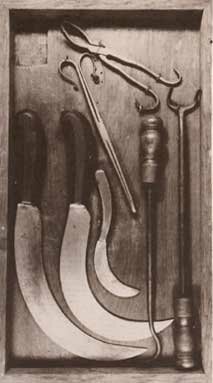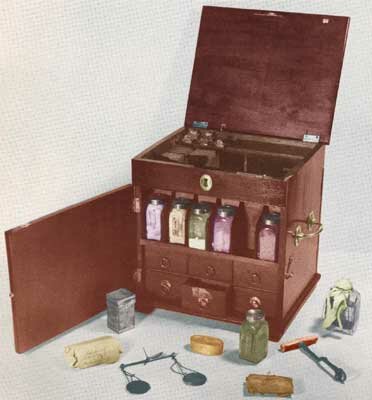
This section focuses on the major players involved in dispensing health care in the 18th century. Of these, the midwife probably would not have had too much interaction with pirates simply because of the nature of her duty. The nurse is notably not listed. Why you may ask? the nursing profession was very much in its infancy during the Golden Age of Piracy. The role of the nurse was most often filled by religious orders such as nuns, friars, and monks. Often they had little or no actual medical training. The most valuable service of these "nurses" was in the comforting of the sick and dying. Other duties including cleaning rooms, removing the dead, and other duties commonly done by the hospital house staff in today's hospitals. It was not until near the end of the 18th century the concept of nursing profession we know today became a reality.
Apothecary: The Pharmacist
Often the Apothecary is seen as nothing more than pharmacist but in the 18th century he not only dispensed drugs but he diagnosed patients and prepared drugs from recipes (Prescriptions) . In the 18th century, Apothecaries and physicians were rivals in that both felt they could diagnose a problem and prescribe the correct remedy. In fact, in Britain, their was no real distinction between the apothecary and physician. The three major hospital in London concentrated on teaching the art of surgery and offered a minimal number of courses on medicine that last ten to twelve months. After this minimal course work, the Apothecary would be finished with his studies and be ready to practice medicine and could fill the role of a physician (but not a surgeon). English physicians who wanted to get a more substantial education in medicine would leave England for France (that is when the two countries were not at war) where physicians received a much better education in medicine.
As for the common Englander of the day, most did not see a distinction between the apothecary or the French schooled English physician and would go to whichever one was available. Surgeons also held a disdain for both and considered them both inferior men of medicine.
According to some records, pharmacist (apothecaries) would make recipes from all sorts of things. In Tobias Smollett's fictional work, Roderick Random, the pharmacist in the story would make drugs from ground up shells , flower petals and something to disguise the natural color of the concoction. Such was the state of on board medicine in the 18th Century; the necessary pharmaceutical ingredients would quickly run out or were never brought on board the ship and the ships doctor would just make do.
Pharmacists in the 18th century carried certain commonly used ingredients to make medicine. Some such ingredients were sulfur, mercury, and charcoal. Certain acids and salts were also carried. On top of these ingredients, leeches for bleeding a patient were also an item kept by pharmacists.
Just as today, an apprentice or assistant pharmacist on a ship is known as a "Pharmacist's Mate". Depending on his level of knowledge he may have been a Pharmacist 1st, 2nd or 3rd mate. If more than one pharmacist were aboard, one would be the Chief Pharmacist.
The Pestilence Section is closely related to treatment expected from Apothecaries.
Barber Chirurgions: A surgeon
There is much discussion over barbers that were surgeons. The barber-surgeon came into existence in the mid 1500s. The profession came under increased scrutiny starting near the end of the 1600s and was formally discredited in England in 1745. By the time of the Golden Age of Piracy, barber surgeons were more often relegated to lancing boils, pulling teeth and performing other types of minor surgeries. They were put out of business by the more powerful and better trained surgeons being trained in the well established Colleges of Surgery that had formed throughout Europe. By the 18th century, barber surgeon were ill trained in the more advanced methods of surgery and healthcare. They were snubbed by the university trained surgeons and physicians. Many were taught by other barber surgeons and lacked any formal training.
The Pain Section is closely related to the treatment expected from Barber Surgeons.
Chirurgion: surgeon

18th Century Surgeon's Kit
A surgeon is one who practices the art of healing by manual operation; a practitioner who treats wounds, fractures, deformities, or disorders by surgical means.
The surgeon of the 18th century would most often learn his craft at a College of Surgery, somewhere in Europe. Strangely most of the lessons were taught in Latin and thus most surgeons were fluent in that language. While some surgeons still learned their craft through an apprenticeship, it was more common for a promising apprentice to work with a surgeon for some time, earning either money or qualifications that would allow him to attend a Surgical College. By the 18th Century, England and other European countries saw the need for qualified surgeons and physicians aboard ship. Therefore it was possible for commoners with little money but great promise to attend surgical colleges, if they arrived at the college with the right recommendations. As such a promising surgeons mate may aid a ship's surgeon for several years and then be sent off to the College of Surgeons, with the understanding he would then serve several more years in the King's Navy.
It should always be understood that their was defined difference between Surgeons and Physicians. Surgeons cut people where as Physicians usually treated people with drugs and or types of therapy. During the 18th Century the divide between the two professions was very distinct and often bitter.
Like the Pharmacist the apprentice or assistant surgeon on a ship is known as a "Surgeon's Mate". Depending on his level of knowledge he may have been a Surgeon's 1st, 2nd or 3rd mate. If more than one Surgeon were aboard, one would be the Chief Surgeon.
A surgeon on a Royal (British) Navy ship or privateer was often the third highest paid officer on board. Only the ship's captain and the his lieutenants made more money. A surgeon mate however was paid about the same as carpenter's mate. This was more than a common sailor but drastically less than the surgeon. This show just how important the Surgeon was considered but at the same time showed that the surgeons mate was did not have same prestige.
The Pain Section is closely related to treatment expected from Surgeons.
Farrier: A Horse Doctor, Veterinarians
By Definition a farrier is one who shoes horses; a shoeing-smith; hence, also one who treats the diseases of horses. Veterinarians are those who are skilled in, or professionally occupied with, the medical and surgical treatment of cattle and domestic animals; a veterinary surgeon.
A pirate would not search out a vet to care for a sick horse. Farrier's or Vets were skilled in the art of setting broken bones. They also knew a thing or two about surgically removing parts of animals. As such they made a better second choice for a surgical routine than some physicians.
As can be expected as time passed and surgeons became more powerful, regulatory acts were passed to prevent farriers from practicing medicine on people.
The Pain Section is closely related to treatment expected from Farriers.
Midwife
The midwife is a woman who assists in the labor and delivery of newborns and the immediate postpartum care of the mother and child. For the most part during the 18th century they had no formal medical training and were not licensed by any over-seeing body.
Up until the 18th Century, the art of child birthing was almost solely in the hands of midwives (women) but this was to change as surgeons began to assert their authority over child birthing. Much of this can be attributed to the Chamberlen family. One Peter Chamberlen developed a pair of obstetric forceps that aided in the delivery of difficult births. The closely guarded family secret was used to amass a fortune for not only Peter but his later descendents. By the 1700s the Chamberlen's were birthing children for all those who could afford their service. The Chamberlen's became quite powerful in the field of child birthing and tried at various times to organize the midwives into a guild in an effort to supposedly to create a regulatory body for proper training but more likely to monopolize the practice in an effort to control all midwives and make lots of money.
While the Chamberlen's were unsuccessful in their efforts (as the Surgeons guild had been many years before) the accusations of poorly trained and uneducated midwifes helped to bring about a demise of the profession as it was known up to that time. By the end of the 18th Century, the use of midwives had decreased significantly among those with money.
Midwives were not highly regarded by other medical professions at the close of the Golden Age of Piracy. However, They also had very little in the way of formal medical education. Today, some historians look back on the practices of 18th Century midwife and see that most of the charges made by other medical professions were correct. It is unfortunate, however, that the other medical professions did not look inward to see their own unsound medical practices.
With that said, if no other medical professional were available during a medical emergency, I'd hazard to guess a desperate pirate might accept the aid of midwife. To seek out the aid of midwife might be a little harder for a pirate to do simply because of the attitudes of society during the 18th Century. It is very doubtful that the opinion of a midwife would even be considered by a college trained surgeon of physician.
The Pain, Pestilence, and Quackery all relate to the treatment given by Midwives.
Physik (Physic): The Physician
The physician is one who is trained and qualified to practice medicine; esp. one who practices medicine as opposed to surgery.
No truer words were spoken in the 18th Century. Physicians were not trained to amputate and sometimes lacked the necessary skills to set a broken bone. Physicians treated diseases and infections through medicine. Often this was unfortunate for the physician captured by pirates. Pirates really weren't too concerned about what the qualifications of a captured medical man were. Thus aboard a pirate ship, the physician may find himself pressed into service as surgeon and an assistant to the cook if that is what the captain wanted and if the physician wanted to live.
This often would bode poorly for the poor pirate needing a limb removed because it was quite possible a butcher would know better how to cut off a leg than a physician.
Similar to surgeons of the 18th century, many physicians were schooled in a College of Physicians and at least had a thorough knowledge of anatomy. They would also know the difference between infections and mortification of the flesh. Physicians in Britain however were not as well schooled as those in other European countries.
Like the Pharmacist and Surgeon the apprentice or assistant physician on a ship is known as a "Physician's Mate". Depending on his level of knowledge he may have been a Physician's 1st, 2nd or 3rd mate. If more than one pharmacist were aboard, one would be the Chief Physician.
The Pestilence Section is closely related to treatment expected from Physicians.
Quack
By definition a Quack is an ignorant pretender to medical or surgical skill; one who boasts to have a knowledge of wonderful remedies; an empiric or impostor in medicine. During the Golden Age of Piracy, quacks were individuals who invented and sold so-called "patented" remedies of medicines. The main reason quacks thrived during the 18th Century is because the medicines and treatments of physicians and surgeons had a poor success rate. There were actually instances where quacks had better success at treating certain ailments than trained physicians.
As you can assume, quacks did not refer to themselves as quacks. Quacks used such titles as "Doctor" and "Professor".
As can be expected, the section on Quackery would best relate to Quacks, however Quacks looked for remedies of ailments mentioned in the Pestilence Section.
Pirate Doctors
For the most part, doctors did not willingly volunteer to serve among pirate ships so most pirate crews sailed without the good fortune of having a doctor on board.
Privateers on the other hand, being commissioned by a government or government body, would usually secure the service of a doctor. We know from records kept during the American Revolution that doctors aboard Privateers were the third highest paid member of the crew. Only the Captain and his lieutenant (a quartermaster on a pirate ship) were paid more than the doctor.
Unlike privateers, pirates usually obtained a doctor using the same method they obtained all their other booty. When they looted a ship or sacked a town they would kidnap the doctor or person with any medical background. Pirates would offer doctors the opportunity to sign articles but most doctors would refuse. When this happened, the pirate captain would offer the doctor safe passage on the ship in return for providing medical service to the crew. The doctor would also be given a share of the loot, often off the books. These steps were done so that in the event the ship was captured by authorities the doctor could claim to be a prisoner and avoid hanging. The hope of the pirate was that by protecting the doctor from the hangman's noose (by not making him sign articles and more or less claiming him to be a prisoner), the doctor would perform his duties. Depending on the pirate captain, many doctors would be released, once their services were no longer needed, at the first safe port of call.
When it came to non-monetary booty, medical supplies probably came right after nautical charts. If pirates had boarded a ship that possessed any medical books or medicines; the pirates would take them. Any person who could read the books or had inkling of what the medicines were, might become the ship's doctor.
When a real doctor was not being pressed into service, pirate relied on other pirates to do the job. This often meant anyone who had witnessed an amputation in the past or had assisted a doctor with an amputation.
Two of the most famous "Pirate Surgeons" is Alexander Exquemelin, who wrote Buccaneers in America, and Lionel Wafer, who is known as the Surgeon to the Buccaneers. Among their adventures was the attack on Porto Bello. Wafer was surgeon to Bartholomew Sharp's crew during their famous South Seas adventure in 1680. Wafer also wrote an account of his exploits as he crossed the Darien Isthmus (Isthmus of Panama). During this exploit he suffered a leg injury and spent some time among the Cuna Indians. Both men were naturalists and produced art work of their adventures that was later published. However, neither Exquemelin or Wafer were true pirates in that their adventures, were commissioned affairs sailing under Letter of Marque, making both men privateers.
There is at least one account of a pirate by the name of William Taylor who had his leg amputated by a ship’s carpenter. Little is known about the pirating career of Taylor except that his pirate captain was named Phillips and that Taylor was tried and convicted to be hanged in Boston on May 4, 1712.
Taylor’s leg was in a bad way and it was unanimously agreed upon by the ship’s officers that he would die unless the damaged part was amputated. Unfortunately the ship had no surgeon, and being pirates, they could not just pull into any port and look for a surgeon. After a brief council it was agreed that the carpenter was best suited to do the job.
According to the eyewitness testimony, the carpenter went about his task with vigor, understanding the need for a speedy operation. He grabbed Taylor’s leg under his arm and with a large saw cut the leg off as quickly as possible. The account explains that the unnamed carpenter understood the need to stench the flow of blood so using a heated blade of an axe, he cauterized the wound. Unfortunately in the process, he also damaged other skin around the wound and the leg began to mortify.
The account does not explain what steps were taken after mortification set in. Normally this would involve amputating more of the leg. It is doubtful, due to the date of the operation, that Taylor’s leg was amputated above the knee. (The screw tourniquet had not been invented yet). It is possible that Taylor was left in Boston were he was seen by a proper surgeon who performed a second operation. Or it is possible that the account referred to an infection that was fought off as gangrene.
In either case, Taylor ended up in Boston facing the gallows. According to the account he was reprieved from hanging for an unknown reason. In this case, the reprieve may have been given by a sympathetic judge who imagined Taylor had suffered enough with the recent amputation of a leg.
The Physician's Medicine Cabinet

To the left is an 18th century Physician's medicine cabinet. The cabinets were carried on board ship and into battle and were considered portable hospitals. Various powders, a measuring scale, and small items wrapped in oil soaked paper are visible, The cabinet is made of mahogany with brass fittings. This small cabinet was all that stood between the pirate and pestilence.

The only author and editor of all pages on the site. Most of what I write about is based on years of book reading on the topic. My first web page was published back in 1994.